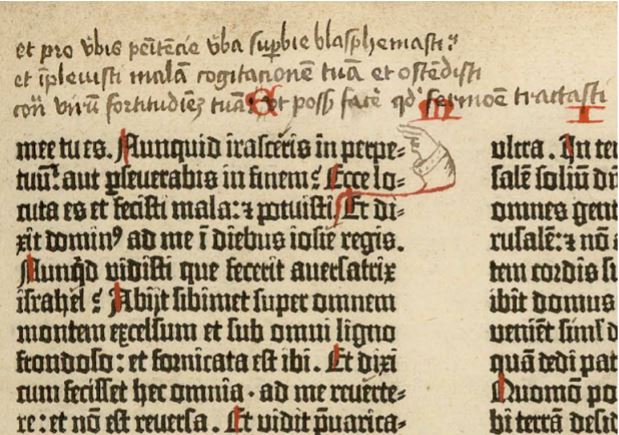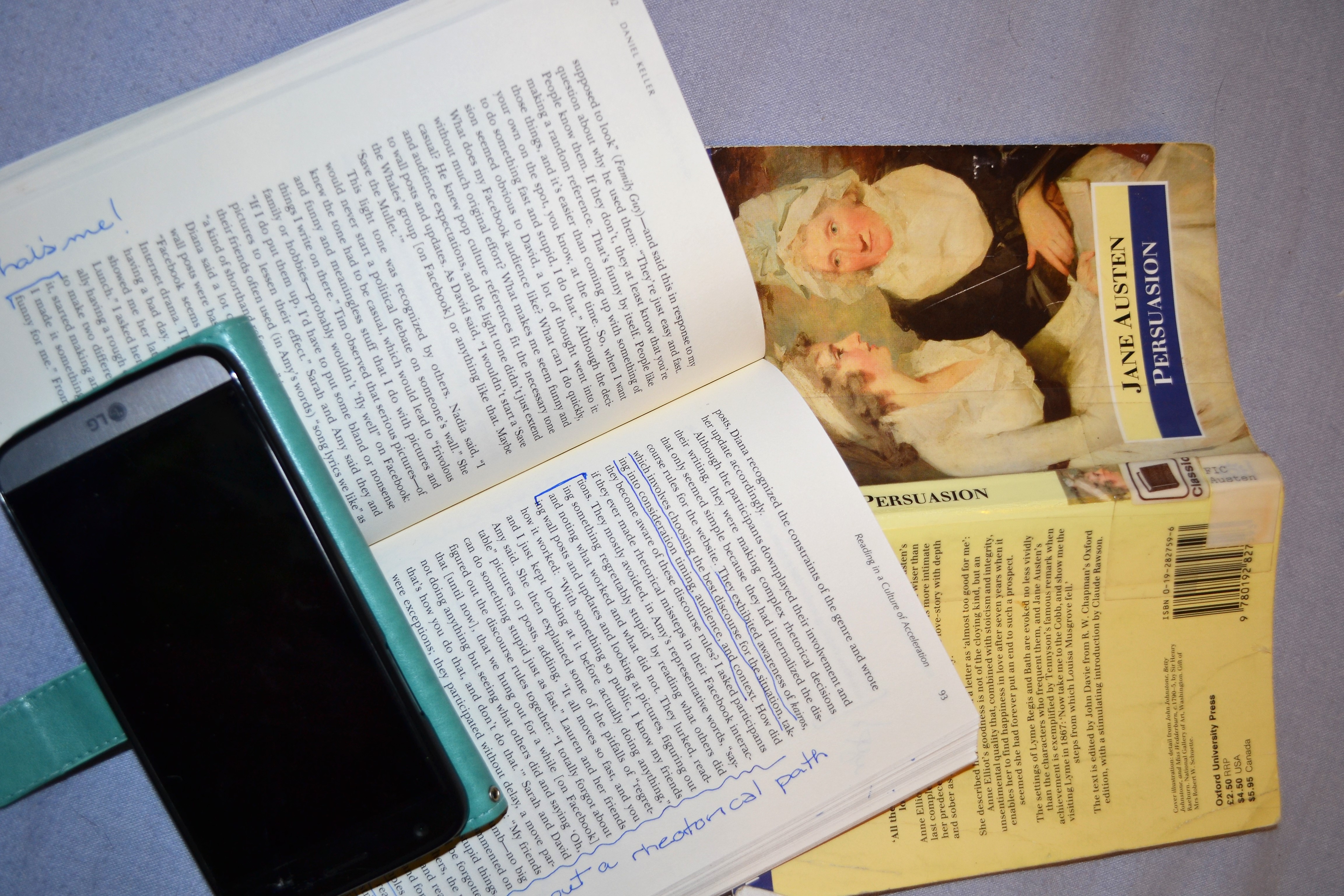I was very glad that Daniel Keller’s Chasing Literacy was included in the readings for ENG-W682. I have wondered about the future of reading and its place in the Composition curriculum for a while now.
My colleagues bemoan student’s reading skills. They worry that students aren’t reading books anymore. A few literature colleagues argue that if we based composition classes around literature that we could solve the deep reading problem. Others (myself included) argue that a curriculum based solely on fiction/poetry/drama privileges the discipline of literature studies. We have some who feel that we need to be teaching students to compose in various digital media while others believe that if we do so we’re not teaching students the very necessary skill of writing. At my institution, I have definitely seen Virginia Anderson’s “Digital Divide” among educators (qtd. in Keller 158).
However, while Anderson argues that instructors who embrace digital media are seen as “responsible” while traditionalists are viewed as “irresponsible” (qtd. in Keller 159), the responsible/irresponsible pendulum swings both ways at my institution. One of our literature specialists once said that he would refuse teach Composition “until it got some content.” It is indeed as Keller points out: “As literacies accumulate and accelerate, the divisions between these teachers may grow even wider” (159).
I agree with Keller when he argues that this curricular divide stems from a misunderstanding of the so-called digital natives. In his examination of multitasking, Keller states, “Assumptions that teens have a kind of all-encompassing digital expertise can lead to questionable pedagogies” (109). Whether it’s a “Return to Literature” or “Digital Now!” the pedagogy is misguided. Young people are not “All digital all the time,” and they are certainly reading long-form works. The evidence from the Pew Research Center is clear: Print and digital both have their value, even among those digital natives. Those 18-29 have read more books in the past year than those 30 and above (Perrin). Moreover, while 35 percent of those 18-29 have read an e-book, twice as many have read a print book (Perrin).
In short, I return to my last post: Digital or print is a false dilemma. We need a pedagogy that reflects the state of modern reading, one that reflects the value and use of digital and print media. For instance, magazine and newspaper reading has always seemed rather disposable to me. These texts printed on cheap paper, and the information was almost always time sensitive. Today’s news was always tomorrow’s birdcage lining.
http://giphy.com/gifs/l6jSO9jvkQ2wU
GIF made by Leslie Johnson, using Giphy via the Comedy Central website.
So, what’s wrong with saving resources and moving such writing to the digital realm? If we’re reading a book for pure enjoyment, what’s wrong with reading it on a Kindle? On the other hand, if we really need to read closely and carefully, what’s wrong with teaching students to use a print text and write in it? Maybe if we can save them money with appropriate digital texts, they’ll actually be more willing to scribble all over a few books that really need a deep read.
As Keller points out, modern computing and the internet have clearly created digital natives who have some intuitive understanding of how audience and purpose change their writing. He explains how his study participants would craft their Facebook posts to meet the requirements and norms of the genre. “Although the participants downplayed their involvement and their writing, they were making complex rhetorical decisions that only seemed simple because they had internalized the discourse rules for the website,” Keller writes. “They exhibited awareness of kairos, which involves choosing the best discourse for the situation, taking into consideration time, audience, and context” (93).
Likewise, he demonstrates how these same digital natives have an intuitive understanding of what texts and purposes need what kind of attention during reading. In his example of David switching between a simple game and checking an eBay auction, Keller illustrates how these digital natives are not mindlessly wondering between media. “[David] probably would have performed better on the game had he not been switching to other tasks, but that misses the point,” Keller says, “he chose the game because it was inconsequential, which reflects an awareness of priorities” (109). Instead of dismissing what these digital natives bring to the literacy table, we need to build upon the skills they already have.
Because it has long been on my mind, I gladly take up Keller’s call to “study and teach a range of rhetorical speeds” and that we recognize “a continuum of faster and slower rhetorics” (163). Based on my experience of logging my own writing tasks for a day and Jill McGrath’s idea of a “reflection activity where [students] explicitly analyze the patterns they see emerging when they are reading both types of texts, when they are researching, and when they are scanning,” I want my new pedagogy to include a strong metacognitive component. The digital age requires students, as they move between rhetorical situations and reading contexts, to be hyper-aware of the decisions they are making and judging the effectiveness of those decisions.
When I return to Composition I in the fall, I imagine that my students will read Malcolm Gladwell’s Outliers, LCC’s OneBook selection for 2017-18. I think I actually might collect the book at semester’s end and give a grade on their annotation of the text. Of course, I think this would also require some instruction on the history and importance of marginalia and interaction with print text.

Commentator’s marginalia on the Book of Jeremiah in a Gutenberg Bible. Photo from the University of Texas Harry Ransom Center.
I would also like to find a way to incorporate some relevant digital reading of their choice. At this point, I think I need also an assignment where they discover, read, and share a wide variety digital texts of their choice relevant to the issues we discuss from Outliers. All the time, I want them to keep a journal that reflects on their literacy habits, including some focused questions about the relationship between print and digital formats.
Although I don’t know all of the details yet when it comes to actual lesson plans and assignments, this course has taught me to firmly believe that we must not only have students thinking about their own literacy practices, they and their teachers must both constantly consider the interplay between print and digital media if we are to make sense of literacy in the twenty-first century.
Works Cited
Keller, Daniel. Chasing Literacy: Reading and Writing in an Age of Acceleration. Logan, UT: Utah St. U Press, 2014.
“Marginalia.” Harry Ransom Center. University of Texas at Austin, n.d. Web. http://www.hrc.utexas.edu/educator/modules/gutenberg/invention/marginalia/
McGrath, Jill. Discussion post. “Week 8: Digital Literacy, Comprehension, and the Classroom. ENG-W682 Literacy. Indiana University-East, 2 Mar. 2016.
Perrin, Andrew. Book Reading 2016. Pew Research Center, 1 Sept. 2016. Web. http://www.pewinternet.org/2016/09/01/book-reading-2016/

Because sometimes, the best literacy use of your cell phone is holding open your book while you write your essay on that book. And by the way, Jane Austen is there because I lost power for two days. Without the ability to charge my phone and read my favorite e-texts, I turned to an old favorite and my camping headlamp.

Hiya Leslie!
Gosh, there are so many interesting points to interact with here. I’ll choose two in order to keep things brief.
I want to respond to that comment one of your colleague’s made: “One of our literature specialist once said that he would refuse teach Composition “until it got some content.” It is indeed as Keller points out: “As literacies accumulate and accelerate, the divisions between these teachers may grow even wider” (159).”
I read something interesting once from Downs & Wardle (yep, the same Wardle we are reading in our course) that we should be considering the teaching of composition not merely as a skill or tool but as a discipline with history much the way we might teach the history of psychology, for example (my comparison, not hers):
Downs, Douglas and Elizabeth Wardle. “Teaching about Writing, Righting Misconceptions: (Re)Envisioning “First-Year Composition” as “Introduction to Writing Studies.” CCC 58.4 (June 2007) 552-585.
I agree with this and think that it can be indeed useful to help students see writing as a discipline and I am considering how I might go about this as I plan my fall Comp 1 at the new university I’ll be teaching at (in Europe, comprised of almost 100% L2 students). In a way, teaching a history of composition includes histories of communication and rhetoric and is an exciting prospect. I am considering how studying traditions of composition can inform not just today’s realities but where we’re heading as well. And as for your colleague wishing for content, I’d love 5 minutes with that person! LOL! There is so much amazing content to explore in comp courses – from writer’s writing about writing to exploring examples of writing – not to mention the potential to thematize a comp course (as so many of our great universities do as part of their “Writing Programs”).
And I LOVE this: “Although I don’t know all of the details yet when it comes to actual lesson plans and assignments, this class has taught me to firmly believe that we must not only have students thinking about their own literacy practices, they and their teachers must both constantly consider the interplay between print and digital media if we are to make sense of literacy in the twenty-first century.”
Absolutely! The teaching of writing must be a lively and dynamic practice that considers contemporary paradigms of communication and expression! Imagine a physician who doesn’t consider modern technology and its impact on both health and medicine! You suggested that your students could keep a journal that reflects their literacy habits. Have you considered having them maintain online journals? I’ve been requiring students to maintain WordPress journals as “Personal Learning Environments” for the last 10 years. The advantages to digital journals (as I know you know) include the ability to select privacy settings of various posts/pages; convenient access to student work by the instructor and other students; the creation of authentic audiences; the ability to explore, link to, and interact with other digital technologies, etc. Even more importantly they require considerations of digital and visual rhetoric. I hope you’ll stay in touch and let me know how your pedagogy develops!!!!
Warmly,
Marlen : )